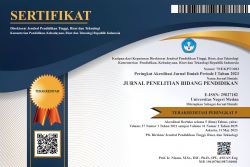PENGARUH STRATEGI PEMBELAJARAN DAN MINAT BELAJAR TERHADAP HASIL BELAJAR KONSTRUKSI POLA PADA SISWA SMK NEGERI 8 MEDAN
DOI:
https://doi.org/10.24114/jpbp.v18i3.4294Keywords:
Strategy learning, pattern construction, ekspositori, STAD.Abstract
Vocational schools (SMK) is a secondary education that preparesstudents primarily for working on a particular field. Diverse efforts made by SMKgraduates increased 8 Medan include improving the quality of education byreforming both the substance of the material and the provision of facilities andinfrastructure. However, the results have not been up, cermatan can be seen fromthe low competence of graduates, making it less able to play a role in meeting thedemands of the workplace. Assumed to be an indication of the quality of learning isstill performed during less effective, less efficient and unable to increase studentinterest. In order to achieve maximum learning outcomes is through theimprovement of learning strategies to utilize the educational facilities in accordancewith existing conditions, ie, by examining one of the subjects namely Constructiondressmaking pattern. Construction material pattern done with learning strategyapproach manipulated into two comparing results STAD cooperative learningstrategies and learning strategies expository and compare the results with thelearning characteristics of students with high and low interest in learning onlearning outcomes Pattern Construction.References
Arends, R., , Classroom Instruksional and
managament, Mcgraw Hill Book, New
York. 1997
Arikunto, S. 2002. Dasar-dasar Evaluasi
Pendidikan. Jakarta: Bumi Aksara.
Carin, A., 1993. Teaching Modern Science.
Macmillan Publishing Company, New
York.
Degeng, S, Nyoman, 1989. Ilmu Pengajaran
Taksonomi Variabel. Jakarta: P2LPTK
DIKTI, Depdikbud. RI.
Djaali. 2006. Psikologi Pendidikan. Jakarta:Bumi
Aksara.
Gagne, R,M. 1989. The Conditioning of Learning
(3
Ed). New York : Hall Rinehort and
Winston,
rd
Gerlach, Vernon S. Ely, Donald P.1980.
Teaching and Media : A Systematic
Approach. New Jersey : Prentice Hall Inc.
Gerungan. 1991. Psikologi Sosial. Jakarta: Bumi
Aksara.
Lungdren, L., 1994.Cooperative Learning in the
Science Classroom, McGraw Hill
Companies, New York.
Mahbub H. 2009. Jumlah Pengangguran di
Indonesia 9,43 Juta Orang.http://
www.tempo interaktif.com.
Merill, M. D. 1983), Component Display Theory.
New Jersey : Lauwrence Elrbaum.
Natawijaya, R., 1996, Psikologi Pendidikan.
Jakarta: Rineka Cipta.
Perdy K. 2001. Penerapan Pendekatan
Keterampilan Proses dalam Seting
Pembelajaran Kooperatif Tipe Jigsaw
untuk Meningkatkan Kualitas Belajar
IPA Siswa SLTP. www.depdiknas.go.id.
Regeluth, C.M., 1983. Instruksional Design
Theories and models : An overview of
their Currect Status. London:
Lauwrence Erlbaums Assosiates.
Sanjaya, Wina. 2009. Strategi Pembelajaran
Berorientasi Standar Proses Pendidikan.
Jakarta: Kencana Predana Media Group.
Slamet. P. H., 1999. Polemik Efesiensi dan
Inefesiensi Pendidikan Kejuruan. Majalah
Forum PTK Edisi IV Februari 1999.
Bandung: FPTK IKIP Bandung.
Slavin RE. 2005. Cooperative Learning: Theory,
Research and Practice (2 ed.) Boston :
Allyn and Bacon Publiher.
Suryabrata,S.Psikologi Pendidikan. Jakarta:
Rajawali Pers. 2004.
Thomson, M., McLughlin, C.W., dan Smith,
R.G., Merryl. 1995. Physical Science
Teacher, Wraparound Edition, Glancoe
Mc Graw-Hill, New York.
Walgito, Bimo, 1981. Psikologi Umum.
Yogyakarta : UGM Pers.
Wena, Made,2009. Strategi Pembelajaran Inovatif
Kontemporer. Jakarta: Bumi Aksara
Downloads
Published
Issue
Section
License
Authors who publish with this journal agree to the following terms:
a. Authors retain copyright and grant the journal right of first publication with the work simultaneously licensed under a Creative Commons Attribution License (https://creativecommons.org/licenses/by/4.0) that allows others to share the work with an acknowledgement of the work's authorship and initial publication in this journal.
b. Authors are able to enter into separate, additional contractual arrangements for the non-exclusive distribution of the journal's published version of the work (e.g., post it to an institutional repository or publish it in a book), with an acknowledgement of its initial publication in this journal.
c. Authors are permitted and encouraged to post their work online (e.g., in institutional repositories or on their website) prior to and during the submission process, as it can lead to productive exchanges, as well as earlier and greater citation of published work (See The Effect of Open Access).

